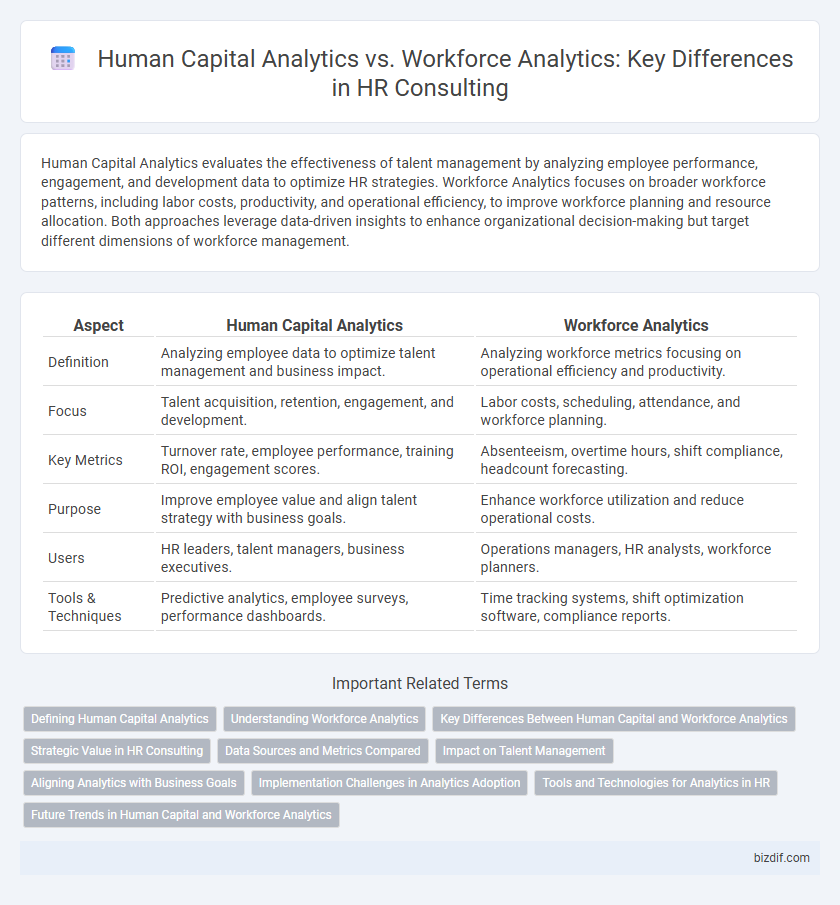Human Capital Analytics evaluates the effectiveness of talent management by analyzing employee performance, engagement, and development data to optimize HR strategies. Workforce Analytics focuses on broader workforce patterns, including labor costs, productivity, and operational efficiency, to improve workforce planning and resource allocation. Both approaches leverage data-driven insights to enhance organizational decision-making but target different dimensions of workforce management.
Table of Comparison
| Aspect | Human Capital Analytics | Workforce Analytics |
|---|---|---|
| Definition | Analyzing employee data to optimize talent management and business impact. | Analyzing workforce metrics focusing on operational efficiency and productivity. |
| Focus | Talent acquisition, retention, engagement, and development. | Labor costs, scheduling, attendance, and workforce planning. |
| Key Metrics | Turnover rate, employee performance, training ROI, engagement scores. | Absenteeism, overtime hours, shift compliance, headcount forecasting. |
| Purpose | Improve employee value and align talent strategy with business goals. | Enhance workforce utilization and reduce operational costs. |
| Users | HR leaders, talent managers, business executives. | Operations managers, HR analysts, workforce planners. |
| Tools & Techniques | Predictive analytics, employee surveys, performance dashboards. | Time tracking systems, shift optimization software, compliance reports. |
Defining Human Capital Analytics
Human Capital Analytics refers to the process of collecting, analyzing, and interpreting data related to employees' skills, performance, and engagement to optimize workforce productivity and align talent strategies with organizational goals. It focuses on measuring human capital metrics such as turnover rates, employee satisfaction, training effectiveness, and recruitment success to drive data-informed HR decisions. Unlike Workforce Analytics, Human Capital Analytics emphasizes the value and potential of individual employees as key assets in achieving long-term business success.
Understanding Workforce Analytics
Workforce Analytics focuses on analyzing employee data to optimize talent management, improve productivity, and align workforce strategies with business goals. It involves tracking metrics such as employee engagement, turnover rates, and skills inventory to provide actionable insights for decision-making. Unlike Human Capital Analytics, which emphasizes the value and ROI of human assets, Workforce Analytics prioritizes operational efficiency and strategic workforce planning.
Key Differences Between Human Capital and Workforce Analytics
Human Capital Analytics focuses on measuring employee performance, engagement, and talent development to optimize workforce potential. Workforce Analytics analyzes operational data such as labor costs, scheduling, and productivity metrics to enhance workforce efficiency. The key difference lies in Human Capital Analytics emphasizing strategic talent management, while Workforce Analytics prioritizes tactical workforce optimization.
Strategic Value in HR Consulting
Human Capital Analytics evaluates employee skills, performance, and potential to align talent management with long-term business goals, driving strategic decision-making in HR consulting. Workforce Analytics examines workforce patterns, productivity, and operational metrics to optimize labor costs and enhance workforce planning. Integrating both analytics delivers comprehensive insights that elevate organizational agility and support strategic human capital investments.
Data Sources and Metrics Compared
Human Capital Analytics primarily relies on HR data sources such as employee engagement surveys, performance appraisals, and talent acquisition records, focusing on metrics like turnover rates, employee productivity, and skill gaps. Workforce Analytics expands data sources to include operational data, financial records, and external labor market trends, measuring workforce utilization, labor cost optimization, and predictive staffing needs. Both approaches utilize quantitative and qualitative data but differ in scope, with Human Capital Analytics centered on individual employee performance and Workforce Analytics encompassing broader organizational workforce patterns.
Impact on Talent Management
Human Capital Analytics focuses on measuring and optimizing employee performance, engagement, and development, driving strategic talent management decisions to enhance productivity and retention. Workforce Analytics analyzes broader labor market trends, workforce demographics, and operational metrics, enabling organizations to align talent acquisition and deployment with business goals. Integrating both approaches improves data-driven talent management by combining individual employee insights with macro-level workforce patterns.
Aligning Analytics with Business Goals
Human Capital Analytics focuses on measuring employee performance, engagement, and development to enhance organizational effectiveness. Workforce Analytics encompasses broader labor metrics, including workforce planning, turnover rates, and productivity trends, to optimize operational efficiency. Aligning these analytics with business goals ensures data-driven strategies that improve talent management and drive sustainable organizational growth.
Implementation Challenges in Analytics Adoption
Human Capital Analytics faces implementation challenges such as data integration complexity and resistance from HR teams unfamiliar with advanced analytics tools. Workforce Analytics struggles with aligning diverse data sources across departments, leading to inconsistent metrics and limited actionable insights. Both require robust change management strategies and continuous training to ensure effective analytics adoption and maximize organizational impact.
Tools and Technologies for Analytics in HR
Human Capital Analytics leverages advanced machine learning algorithms and predictive modeling tools to analyze employee performance, engagement, and talent acquisition in real-time, whereas Workforce Analytics primarily utilizes descriptive analytics platforms and business intelligence tools to focus on workforce planning and operational metrics. Key technologies in Human Capital Analytics include AI-driven HRIS systems, natural language processing for sentiment analysis, and cloud-based data integration platforms that enable comprehensive talent insights. Workforce Analytics often relies on traditional data visualization tools like Tableau and Power BI combined with HR reporting software to provide actionable insights on workforce efficiency and cost management.
Future Trends in Human Capital and Workforce Analytics
Future trends in Human Capital Analytics emphasize predictive modeling and AI-powered insights to enhance talent acquisition, performance management, and employee engagement. Workforce Analytics integrates real-time data from diverse sources such as IoT devices and HRIS platforms to optimize workforce planning and productivity. Both disciplines increasingly leverage machine learning algorithms and natural language processing to deliver strategic, data-driven decision-making that aligns human capital with organizational goals.
Human Capital Analytics vs Workforce Analytics Infographic

 bizdif.com
bizdif.com